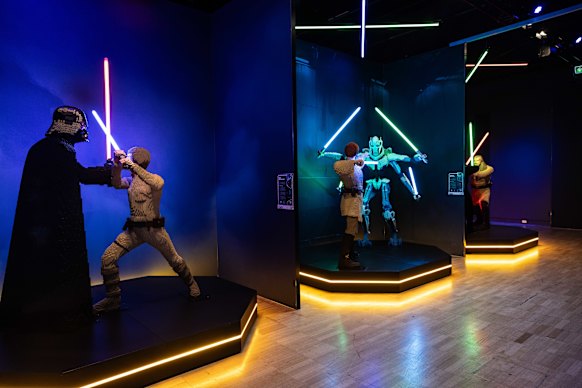Sitting at tables around the warehouse or standing around models are the Lego builders painstakingly placing bricks, after consulting computer models that show the “rough shape” of where the bricks go.
One group of six are working side by side on a giant model of a beanie, which they are creating for a motor neurone disease charity event. Another Lego builder is working on a model of a dinosaur destined for a Lego store in New Delhi in India.
Hamish Blake and Ryan McNaught host Lego Masters.Credit: Nine Entertainment
No photographs are allowed that include any of the Lego builds under construction because of strict confidentiality agreements.
Overhead cameras film each Lego build on time-lapse, with the footage to be released once the build is finished, and small exhaust pipes hang from each work station to extract the fumes from all the glue.
While building Lego might be literally child’s play, McNaught and his team take it very seriously.

Life-sized Star Wars figures made of Lego at Melbourne Museum.
“Everybody knows how to put two Lego bricks together, that’s an easy thing to do,” he says. “We teach a certain method and style of Lego building.”
McNaught says Lego is not designed to be made into giant structures, so there is a lot of skill and technique in the “artistry of Lego” which needs to be taught.
He uses a method called “north, south, east, west”, which means that you alternate direction when building layers of bricks, which helps with strength and stability.
“There’s also a technique we use called SNOT, which stands for studs not on top. We turn bricks in different directions, which give us shearing strength,” he says. “There’s a whole heap of things like that. On average, it takes a person about two years before they’re proficient in those techniques. Call it an apprenticeship, if you will.”
The Lego builders work at adjustable tables to protect their backs, and McNaught says the main occupational hazard is calluses from the hard plastic blocks.
“We have really good calluses on our fingers,” he says. “If you look at anyone who’s a builder, you can see exactly whether they’re left-handed or right-handed or both-handed, because of the calluses.”
McNaught is one of only 21 certified Lego professionals in the world, which gives him permission to use the Lego brand and to contract to Lego.
But this title does not give McNaught any discount on the crates of Lego he purchases.
“We wish,” he laughs. “We pay a fortune for Lego. We’re the No.2 or 3 consumer of Lego in the world.”
Loading
McNaught estimates he has 30 million Lego bricks in his warehouse, with the Star Wars Lego exhibition alone using more than 8 million bricks and taking McNaught and his team more than 25,000 hours to build.
The exhibition opened on Star Wars Day, May 4, and runs until the end of January; 35,627 tickets have already been sold.
Tim Rolfe, director of exhibitions and experiences at Museums Victoria, said the exhibition was on track to be a bestseller.
“In all likelihood, Lego Star Wars will be one of the three or four most popular blockbuster exhibitions ever to be presented at Melbourne Museum,” he says.
Lego Masters airs on Nine. Nine is the publisher of this masthead.
The Morning Edition newsletter is our guide to the day’s most important and interesting stories, analysis and insights. Sign up here.
Read the full article here

